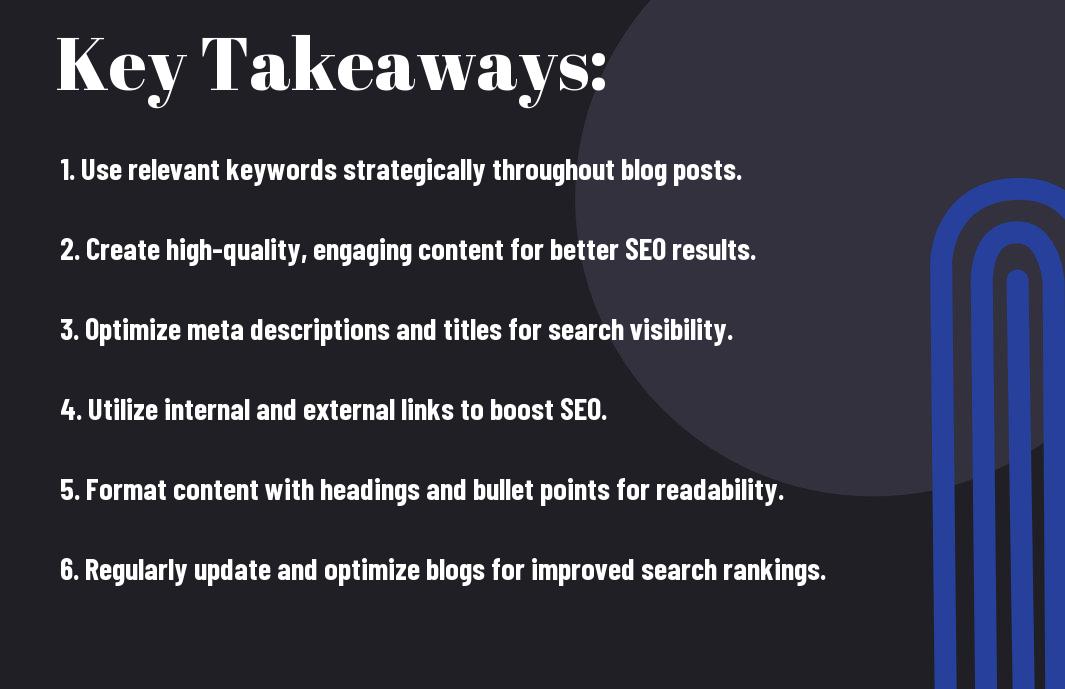Overlooking the significance of crafting your blog posts with SEO in mind can hinder your website’s ranking potential. By understanding key principles and implementing strategic tactics, you can optimize your blog writing to attract more organic traffic. From keyword research to meta descriptions, this guide will equip you with the vital tools to enhance your blog’s visibility and reach a wider audience.
The Importance of SEO in Blog Writing
Why Search Engines Matter
With the vast amount of content available online, it’s crucial to make sure your blog can be easily found by your target audience. This is where search engine optimization (SEO) comes into play. SEO helps improve your blog’s visibility on search engine results pages, increasing the chances of your content being discovered by potential readers.
By understanding how search engines work and optimizing your blog accordingly, you can attract more organic traffic and grow your audience over time.
The Role of Keywords in SEO
The use of keywords plays a crucial role in SEO. Keywords are the terms and phrases that people type into search engines when looking for information. By strategically incorporating relevant keywords into your blog content, you can signal to search engines what your post is about and increase its chances of ranking higher in search results.
This helps your blog attract the right audience and ensures that your content is shown to users who are actively searching for the topics you cover.

Crafting Compelling Headlines
While writing a blog post for SEO, crafting compelling headlines is necessary to attract readers and improve your search engine rankings. A well-crafted headline can pique the reader’s interest and encourage them to click through to your content.
The Power of Keywords in Headlines
Compelling headlines not only capture the reader’s attention but also incorporate relevant keywords to improve SEO. Including relevant keywords in your headlines can help search engines understand the topic of your content and increase its visibility in search results. When selecting keywords for your headlines, make sure they accurately reflect the content of your blog post and match the search intent of your target audience.
How to Write Attention-Grabbing Titles
An attention-grabbing title is crucial for drawing in readers and increasing engagement with your blog post. To create a compelling headline, consider using power words, numbers, and emotional triggers to spark curiosity and encourage readers to click on your post. Keep your titles concise and clear, focusing on the main benefit or takeaway that your content provides to the reader.
Another tip for writing attention-grabbing titles is to A/B test different variations to see which performs best with your audience. By experimenting with different headline formats and styles, you can optimize your titles for maximum impact and improve your click-through rates over time.
Over the years, mastering the art of blog writing for SEO has become vital in the digital world. To ensure your content ranks well on search engines and reaches a wider audience, you must understand the fundamentals of writing SEO-friendly blogs. From incorporating relevant keywords to creating engaging and informative content, optimizing your blog posts can significantly impact your online visibility. In this guide, you will discover valuable tips and strategies to enhance your blog writing skills for SEO purposes.
The Art of Keyword Research
Once again, you find yourself exploring into the world of SEO, eager to improve your blog writing skills. To harness the power of search engine optimization, you must master the art of keyword research. This crucial step will guide you in creating content that resonates with your target audience and ranks well in search engine results. If you’re unsure where to start, check out this helpful resource on How to write SEO-friendly blog posts that rank (in 8 steps).
Identifying Relevant Keywords
An crucial aspect of keyword research is identifying the most relevant keywords for your content. Put yourself in the shoes of your audience and think about what terms they would use to search for information related to your blog post. By understanding the language and phrases your audience uses, you can strategically incorporate those keywords into your content for better visibility and reach.
Tools for Effective Keyword Research
Keywords play a pivotal role in optimizing your blog content for search engines. Tools such as Google Keyword Planner, SEMrush, and Ahrefs can assist you in conducting effective keyword research. By utilizing these tools, you gain valuable insights into search volume, competition level, and related keywords. This data empowers you to make informed decisions on which keywords to target in your content for maximum impact.
This in-depth analysis of keywords allows you to refine your content strategy and focus on high-performing keywords that align with your goals and objectives. Recall, quality keyword research is the foundation of successful SEO practices, so invest time and effort in this critical stage of the writing process.
Optimizing Your Content
Using Keywords Strategically
Now, when it comes to optimizing your content for SEO, strategically using keywords is key. Your primary keyword should be placed in strategic locations such as the title, headers, and meta-description. However, stuffing your content with keywords can do more harm than good. Make sure your content reads naturally and provides value to the reader.
The Importance of Latent Semantic Indexing (LSI)
Latent Semantic Indexing (LSI) is crucial for SEO. By incorporating related keywords and phrases that are semantically linked to your main keyword, you can improve the relevance and context of your content for search engines. This helps search engines understand the topic of your content better and can improve your chances of ranking higher in search results.
A well-implemented LSI strategy can not only help boost your SEO efforts but also make your content more comprehensive and informative for your readers. It can enrich the overall user experience and increase the chances of engagement and conversions on your website.
The Role of Meta Descriptions
What Are Meta Descriptions?
Unlike the main body of your blog post, meta descriptions are the brief snippets of text that appear below the title of a webpage on the search engine results pages. They are like a sneak peek of what the page is about, giving readers a glimpse into what they can expect if they click on the link.
Any time you perform a search on Google, the meta description is what can make the difference between a user clicking on your link or scrolling past it. A well-crafted meta description can entice users to visit your page, increasing your click-through rate and ultimately driving more traffic to your blog.
How to Write Effective Meta Descriptions
Meta descriptions should be concise, engaging, and relevant to the content of your blog post. They should be between 150-160 characters to ensure they are fully displayed in the search results. Make sure to include relevant keywords to increase the chances of your page ranking higher in search engine results.
Meta descriptions also serve as an opportunity to pitch your content to potential readers. By highlighting the value and uniqueness of your blog post, you can attract more clicks and increase the chances of users staying on your site longer.
Meta descriptions play a crucial role in improving your SEO efforts and increasing the visibility of your blog posts in search engine results. By incorporating relevant keywords and crafting compelling copy, you can optimize your meta descriptions to attract more traffic to your blog.

Image Optimization for SEO
Why Images Matter in SEO
Despite their visual appeal, images play a crucial role in optimizing your website for search engines. Search engines like Google not only crawl through text but also through images to understand the content of a webpage. By incorporating relevant images with proper optimization, you can improve your chances of ranking higher in search results. Images can also enhance user experience, making your website more engaging and increasing the time visitors spend on your site.
How to Optimize Your Images for Search Engines
To optimize your images for search engines, you need to focus on a few key elements. Firstly, make sure to use descriptive filenames that include relevant keywords related to the image content. Additionally, provide alt text for each image, which serves as a description for visually impaired users and helps search engines understand the context of the image. Compressing your images to reduce file size without compromising quality can also improve your site’s loading speed, which is a vital factor for SEO.
MatterIt’s vital to choose the right file format for your images. JPEG is ideal for photographs, while PNG is best for graphics with fewer colors. By following these image optimization practices, you can enhance your website’s SEO performance and provide a better overall user experience for your visitors. Bear in mind, optimizing your images is not just about SEO but also about creating a visually appealing and accessible website for everyone.
Internal Linking Strategies
The Benefits of Internal Linking
To improve the SEO of your blog, you need to utilize internal linking strategically. When you link to other pages within your website, you create a network of connections that search engines can follow to discover more of your content. This helps search engines understand the relevance of your pages and boosts your site’s overall visibility.
Best Practices for Internal Linking
To ensure effective internal linking, you should focus on using relevant anchor text that accurately describes the destination page. Additionally, consider the context of the link placement and ensure it fits naturally within your content. Avoid overstuffing your content with links, as this can appear spammy and deter readers.
Another key aspect of internal linking is creating a hierarchical structure within your website. By organizing your content into categories and subcategories, you can guide users and search engines to navigate your site more easily. This not only improves user experience but also helps search engines index your content more efficiently.
Content Length and Quality
The Ideal Content Length for SEO
Many SEO experts believe that the ideal content length for SEO is around 1000-2000 words. This length allows you to cover a topic in depth, incorporate relevant keywords naturally, and provide valuable information to your readers. Search engines tend to favor longer content because it signals to them that the page is comprehensive and authoritative.
An important thing to remember is that quality should always come before quantity. While longer content tends to perform better on search engines, it’s crucial to ensure that your content is well-written, engaging, and informative. Strive to strike a balance between length and quality to create content that both search engines and readers will love.
How to Ensure High-Quality Content
Content quality is crucial for SEO success. From a search engine’s perspective, high-quality content is well-researched, original, and provides value to the reader. To ensure that your content meets these criteria, you should focus on creating engaging and informative pieces that answer your audience’s questions and provide solutions to their problems.
The key to high-quality content is to put yourself in your reader’s shoes. Consider what information they are looking for, what questions they might have, and how you can best provide value to them through your content. By focusing on the reader and delivering content that meets their needs, you can create high-quality pieces that perform well on search engines.

Avoiding Common SEO Mistakes
For How to write blogs to help SEO? Any tips – Newbie, it is vital to avoid common SEO mistakes that can hinder the performance of your blog. One major mistake to steer clear of is over-optimization and keyword stuffing.
Over-Optimization and Keyword Stuffing
On your quest to optimize your blog for SEO, be cautious not to overdo it. Over-optimization, also known as “keyword stuffing,” involves excessively using keywords in your content to manipulate search engine rankings. While keywords are crucial for SEO, stuffing your content with them can lead to penalties from search engines, impacting your blog’s visibility. Instead, focus on naturally incorporating relevant keywords into your content to maintain a balance between SEO optimization and providing valuable information to your readers.
Duplicate Content and Other Common Errors
With a multitude of web pages on the internet, duplicate content can inadvertently appear on your blog. This occurs when identical or similar content exists on multiple pages, leading to confusion for search engines in determining the most relevant page to rank. Duplicate content can dilute the authority of your blog and affect its search engine rankings.
Duplicate content is not limited to exact replicas; it can also include content that is slightly modified or paraphrased. To prevent this issue, regularly monitor your blog for duplication and ensure that each page offers unique and valuable content to visitors. Additionally, address other common errors such as broken links, slow page speed, and missing meta tags to enhance your blog’s overall SEO performance.
Measuring SEO Success
Setting Up Google Analytics
The first step to measuring your SEO success is setting up Google Analytics on your website. This powerful tool allows you to track important metrics such as organic traffic, bounce rate, and conversion rate. By monitoring these metrics, you can gain valuable insight into how well your SEO efforts are performing and make data-driven decisions to improve your website’s search engine ranking.
Tracking Your SEO Progress
Any successful SEO strategy involves tracking your progress over time. One way to do this is by monitoring keyword rankings, which show how well your website is performing for specific search terms. You can also track your website’s backlink profile to see how many other sites are linking back to your content. By keeping a close eye on these metrics, you can identify what is working well and what areas need improvement in your SEO strategy.
Additionally, you can use tools like Google Search Console to analyze your website’s performance in search results, including click-through rates and impressions. This data can help you optimize your content further and improve your SEO efforts to increase your website’s visibility on search engines.
Advanced SEO Techniques
All SEO strategies for blog writing can be enhanced by incorporating advanced techniques. These techniques can help boost your website’s visibility and improve your search engine rankings. Here are some advanced SEO techniques to consider:
-
Using Header Tags and Structured Data
Header Tags Structured Data Utilize H1, H2, and H3 tags to organize your content and improve readability. Implement structured data markup to provide search engines with better context about your content.
Tags for Improved SEO Performance
Header tags (H1, H2, H3, etc.) not only help in organizing your content for readers but also carry significant weight in SEO. Search engines use header tags to understand the structure and hierarchy of your content. By utilizing header tags effectively, you can improve your content’s readability and keyword optimization, ultimately enhancing your SEO performance.
How to Leverage Social Media for SEO
Advanced SEO techniques also involve leveraging social media platforms to boost your website’s visibility. By sharing your blog posts on social media channels, you can increase traffic to your site and improve your SEO rankings. Social signals such as likes, shares, and comments can positively impact your search engine optimization efforts.
With the increasing influence of social media on online visibility, integrating social media strategies into your SEO plan is important. Engaging with your audience on platforms like Facebook, Twitter, and LinkedIn can not only drive traffic to your blog but also improve your website’s authority and credibility in the eyes of search engines.
SEO Tools and Resources
Popular SEO Tools and Plugins
For many bloggers, having the right SEO tools and plugins can make a huge difference in optimizing your website for search engines. Tools like Google Analytics, SEMrush, Moz, and Yoast SEO are popular options that can help you track your website’s performance, conduct keyword research, monitor backlinks, and improve your on-page SEO.
Staying Up-to-Date with the Latest SEO Trends
For keeping up with the latest SEO trends, it’s crucial to stay informed about the ever-evolving landscape of search engine algorithms and optimization techniques. Following industry blogs like Search Engine Land, Moz Blog, and Neil Patel’s blog can provide you with valuable insights and updates on what strategies are working best in the current SEO environment.
With search engines constantly updating their algorithms and ranking factors, staying ahead of the curve by staying informed of the latest SEO trends can help you adapt your blog writing strategies to improve your search engine visibility and drive more organic traffic to your website.
Conclusion
Considering all points discussed in this article, you now have a clear understanding of how blog writing can significantly impact your SEO strategy. By incorporating relevant keywords, creating high-quality content, and optimizing for mobile devices, you can enhance your website’s visibility and attract more organic traffic.
Note, consistency is key when it comes to blogging for SEO. Keep creating valuable content that resonates with your target audience and watch your search engine rankings soar. With the right approach and dedication, you can harness the power of blog writing to boost your online presence and grow your business.

